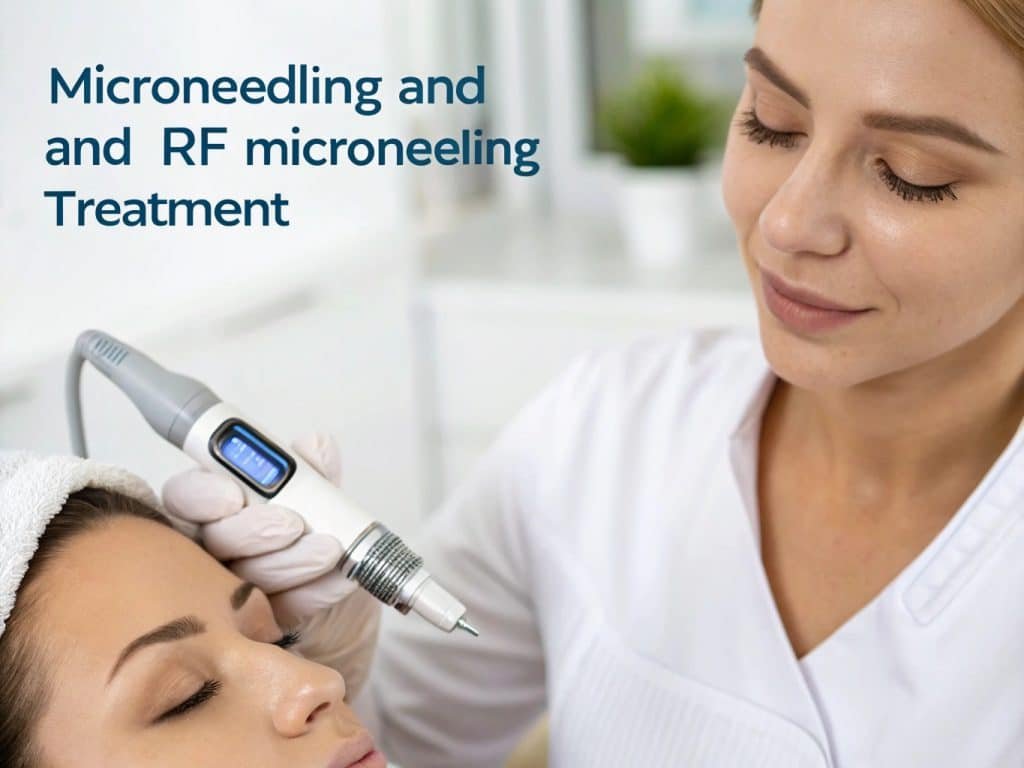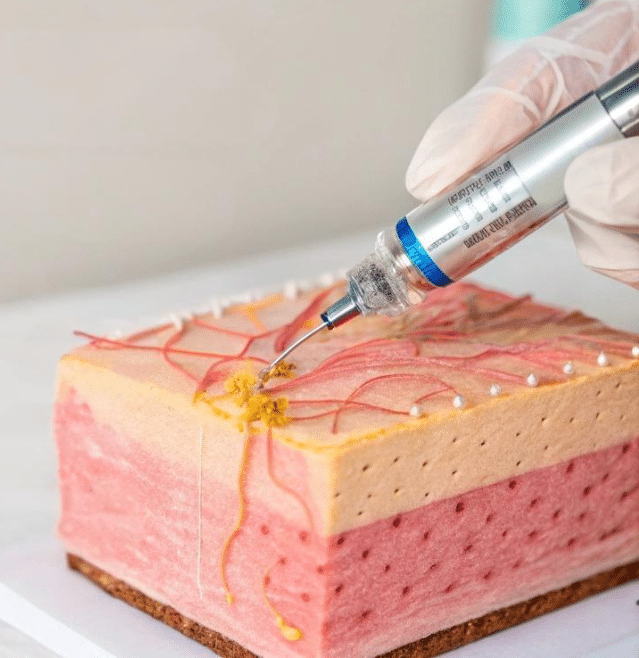Clients are overwhelmed by choices in skin rejuvenation.
They seek clarity on which treatment suits their specific needs.
Both microneedling and RF microneedling boost collagen. But they work differently. One causes a mechanical injury, the other one adds heat. Choosing depends on individual needs and budget.

Let’s examine the fundamental differences.
Understanding the Basics: How Do Microneedling and RF Microneedling Work?
Clients don't know the mechanism of action.Misinformation leads to poor treatment decisions.
How It Works
- Microneedling (Traditional): Tiny needles create micro-injuries. This triggers the body's healing response. It boosts collagen and elastin production.
- RF Microneedling: Combines micro-injuries with radiofrequency (RF) energy. Needles deliver RF heat deep into the skin. This intensifies collagen stimulation and tightens tissues.

Let’s dive into which is best for specific concerns.
Targeting Specific Skin Concerns: Which Treatment Addresses Your Needs Best?
Clients have unique skin issues, not "general" concerns.Generic advice fails them.
Treatment Choice:
- Milder Concerns & Budget-Conscious: Choose traditional microneedling. Ideal for:
- Mild fine lines
- Superficial acne scars
- Uneven texture
- Minimal downtime
- Lower budget
- Moderate/Significant Concerns & Skin Tightening: Choose RF microneedling. Ideal for:
- Moderate/deep wrinkles & laxity
- Deeper acne scars (ice pick, boxcar)
- Stretch marks
- Enlarged pores
- More dramatic tightening

Next, how deep do these treatments go?
Treatment Depth and Intensity: How Do the Procedures Differ?
Clients don't understand penetration differences.They may assume "deeper is always better."
RF microneedling generally reaches deeper layers of the dermis. Traditional microneedling is typically more superficial.
Depth Control:
- Needle Length: Adjustable in both, but RF often goes deeper (0.5mm - 4mm).
- RF Energy: Controls the thermal impact zone, reaching deeper tissues.
- Insulated Needles: It will make RF microneedling only cause thermal effect at the tip of needles, protecting epidermis.

Now, what about recovery time?
Downtime and Recovery: What Can You Expect After Each Procedure?
Clients need to plan around downtime.Unexpected recovery disrupts their schedules.
Microneedling typically has shorter downtime (1-3 days). RF microneedling downtime is longer (3-7 days).
Downtime Timeline
| Phase | Microneedling | RF Microneedling |
|---|---|---|
| Immediately Post | Redness, mild swelling | Redness, swelling, possible pinpoint bleeding |
| Day 1-3 | Redness subsiding, possible dryness | Redness, possible mild flaking |
| Day 3-7 | Usually fully recovered | Most redness gone, slight sensitivity |
| Week 1+ | Skin looks normal, improvements visible | Continued improvement in texture/tightness |
Next up: cost analysis.
Cost Considerations: Which Treatment Fits Your Budget (or Your Clients' Budgets)?
Pricing is opaque, making comparisons difficult.Clients risk overspending or underspending.
RF microneedling is generally more expensive than traditional microneedling. RF devices cost much more.
Cost Factors:
- Device Cost: RF machines are significantly more expensive than basic microneedling pens.
- Consumables: RF needles (especially insulated) cost more.
- Expertise: RF procedures often require more specialized training.
- Geographic Location: Prices vary by region.
How many treatments will be needed?
Number of Treatments Needed: How Many Sessions Are Required for Optimal Results?
Clients want to know the total commitment.Unclear timelines lead to frustration.
Both typically require multiple sessions. RF microneedling may need fewer sessions overall due to its intensity.
Typical Session Count
- Microneedling: 3-6 sessions, spaced 4-6 weeks apart.
- RF Microneedling: 2-4 sessions, spaced 4-8 weeks apart.
What about safety?
Safety Profiles: Are There Any Differences in Risks or Contraindications?
Clients worry about potential side effects.Risk awareness is crucial for informed consent.
Both are generally safe. RF microneedling has a slightly higher risk of hyperpigmentation in darker skin types.
Key Differences:
- Heat-Related Risks: RF adds potential for burns (rare with proper technique).
- Hyperpigmentation: Darker skin tones (Fitzpatrick IV-VI) need careful RF settings.
- Contraindications: Similar for both (active infections, certain medications, etc.).
Which has longer-lasting benefits?
Long-Term Results and Maintenance: Which Option Provides Longer-Lasting Benefits?
Clients want lasting improvements, not temporary fixes.Short-term results waste time and money.
RF microneedling generally provides longer-lasting results. Its deeper collagen stimulation and tissue remodeling are more durable.
Longevity Factors:
- Collagen Remodeling: RF creates more significant and lasting collagen changes.
- Skin Tightening: RF's tightening effects are more pronounced and durable.
- Maintenance: Both require occasional maintenance treatments (frequency varies).
The "Better" Choice: Making an Informed Decision for Your Practice and Clients
No single "best" treatment exists.Clients need personalized recommendations.
Neither is inherently "better." The best choice depends on individual skin concerns, goals, budget, and downtime tolerance.
| Feature | Microneedling (Traditional) | RF Microneedling |
|---|---|---|
| Best For | Mild concerns, budget-friendly | Moderate/severe, skin tightening |
| Action | Mechanical injury | Mechanical + Thermal (RF) |
| Collagen | Good | Excellent |
| Tightening | Minimal | Significant |
| Downtime | Shorter (1-3 days) | Longer (3-7 days) |
| Cost | Lower | Higher |
| Pain | Mild-Moderate | Mild-Moderate |
| Depth | Superficial | Deeper |
| Hyperpigmentation Risk | Lower | Slightly higher in darker skin |
Combining Treatments: Can Microneedling and RF Microneedling Be Used Together?
Clients may want to maximize results.Exploring all options is appealing.
Yes, but not simultaneously. They can be alternated or used in separate treatment plans. This requires expert planning.
Combination Strategies:
- Alternating Sessions: One session of microneedling, followed by RF microneedling weeks later.
- Targeted Approach: RF microneedling for areas needing tightening, traditional for other areas.
- Complementary Therapies: Combining either with PRP, peels, or other modalities.
Conclusion:
Choosing between microneedling and RF microneedling is a personalized decision. RF microneedling offers more intensive results, especially for tightening. Traditional microneedling is excellent for milder concerns and lower budgets. A thorough consultation with an expert is essential, and Delya can help you determine which option is best for your specific needs.
